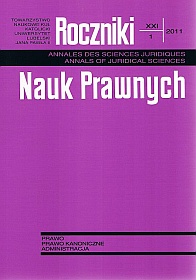Sytuacja prawna Ukraińskiego Kościoła greckokatolickiego w powojennej Polsce. Wybrane zagadnienia
Abstrakt
Decisions made at the Jalta and Tehran conferences produced an agreement concluded between the Union of Soviet Socialist Republics and the Polish Committee of National Liberation, according to which the eastern border of Poland was now marked along the socalled “Curzon Line”, which in fact was an acknowledgement of the status quo from the year before. The border now ran along the Bug River and further south to separate the cities of Lviv and Przemysl, which at the time were the capitals of two largest Greek Catholic dioceses. The new territory of Poland now was home to about 700,000 Ukrainians, majority of whom being Greek-Catholics. On 9 September 1944, the Soviet-dependent Committee signed an agreement on the so-called population exchange with the governments of Soviet republics of Ukraine and Belarus, as well as with Soviet Lithuania on 22 September. This was unquestionably the beginning of activities intended not only to transform Poland into a singlefaith state, but also to eliminate the Greek Catholic church in a systematic fashion. On 4 October 1945 Polish bishops, gathered at a Plenary Conference of Polish Episcopate in Częstochowa, resolved to extend their pastoral care to the Uniate brethren, who had been deprived of their priests and places of worship. After years of harsh persecution, the Greek Catholic Church is now undergoing a vibrant revival, and this fact inspires optimism for the future. The article makes an effort to familiarise the Polish reader with this complex relation between the Church and State during that “inhuman” era in Polish history.
Copyright (c) 2011 Roczniki Nauk Prawnych

Utwór dostępny jest na licencji Creative Commons Uznanie autorstwa – Użycie niekomercyjne – Bez utworów zależnych 4.0 Międzynarodowe.


